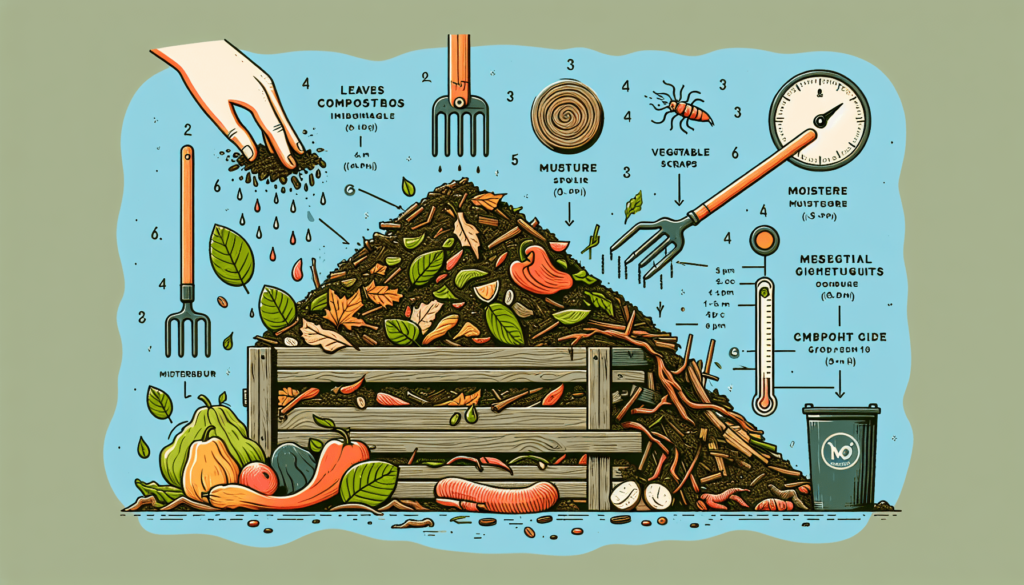Maintaining a compost pile might seem like a daunting task, but fret not! We are here to guide you through the process and make it smooth sailing all the way. In this article, we will share some simple yet effective tips on how to keep your compost pile thriving and producing nutrient-rich compost for your garden. So, if you’re ready to unlock the secrets of successful composting, let’s get started!

Preparing the Compost Pile
Choose a Suitable Location
When setting up a compost pile, it is important to select a suitable location. Ideally, choose an area that receives partial sunlight, as excessive heat can dry out the pile, while too much shade can slow down the decomposition process. Additionally, ensure that the location is easily accessible, allowing for convenient monitoring and management of the compost pile.
Gather Composting Materials
Before starting your compost pile, it is crucial to gather the necessary materials. These include a balanced mix of “green” (nitrogen-rich) and “brown” (carbon-rich) materials. “Green” materials include vegetable scraps, coffee grounds, and fresh grass clippings, while “brown” materials consist of dry leaves, shredded newspaper, and small twigs. Aim for a ratio of roughly three parts “brown” materials to one part “green” materials to achieve a balanced compost pile.
Building the Compost Pile
Layering the Materials
To create a well-structured compost pile, it is important to layer the materials properly. Start by placing a layer of “brown” materials at the bottom, followed by a layer of “green” materials. Alternate these layers until all the composting materials have been used. This layering technique helps promote airflow and prevents the pile from becoming too compact.
Maintaining the Proper Size and Shape
The size and shape of the compost pile are crucial factors in maintaining optimum conditions for decomposition. Ideally, aim for a compost pile that is at least three feet high and three feet wide. This size allows for proper insulation and ensures sufficient mass to generate and retain heat. Additionally, maintaining a conical shape with a slightly rounded top helps to facilitate proper drainage and aeration throughout the pile.
Balancing the Compost
Balancing Carbon and Nitrogen
Achieving the right balance of carbon and nitrogen is essential for successful composting. Carbon-rich “brown” materials provide the energy source for decomposer organisms, while nitrogen-rich “green” materials supply the necessary nutrients. Aim for a carbon-to-nitrogen (C:N) ratio of approximately 30:1. Monitor the pile and adjust the ratio by adding more “green” or “brown” materials as necessary.
Adding Water to Maintain Moisture
Proper moisture levels are crucial for the decomposition process. The compost pile should be moist, but not overly saturated. To maintain the ideal moisture level, regularly check the compost pile and water it if necessary. A good rule of thumb is to aim for a moisture content similar to a damp sponge. If the pile becomes too dry, it can inhibit decomposition, while excessive moisture can lead to unpleasant odors and slow down the composting process.
Turning and Mixing the Compost
Aerating the Pile
Regularly turning and mixing the compost pile helps to promote aeration and facilitate decomposition. This process introduces oxygen, which is essential for the growth and activity of aerobic organisms responsible for breaking down organic matter. Use a pitchfork or a compost turning tool to gently turn the pile from the outside to the center, ensuring that all parts of the pile are evenly mixed.
Mixing the Materials
In addition to turning the compost pile, it is beneficial to mix the materials within the pile. Mixing helps distribute moisture, heat, and microorganisms throughout the compost pile, ensuring that decomposition occurs uniformly. Utilize a garden fork or shovel to thoroughly mix the materials, breaking up any clumps and incorporating them into the rest of the pile. Aim to mix the compost pile every one to two weeks for optimal results.
Monitoring the Compost Pile
Checking Temperature
Monitoring the temperature of the compost pile is vital to ensure effective decomposition. In the early stages, the pile will naturally heat up due to the microbial activity. Use a compost thermometer to regularly check the internal temperature. Ideally, the temperature should reach between 130°F and 160°F (54°C to 71°C). If the temperature drops significantly or fails to rise, it may indicate a lack of decomposition activity or an imbalance of materials within the pile.
Observing Moisture Levels
Regularly observe the moisture levels of the compost pile to ensure it remains adequately hydrated. Use a hand or gardening tool to feel the moisture content within the pile. If the pile feels dry, add water to moisten it, and if it feels overly wet, consider incorporating more dry “brown” materials to absorb the excess moisture. Strike a balance to create the optimal environment for decomposer organisms to thrive.
Managing Odor and Pests
Avoiding Odorous Materials
A well-maintained compost pile should not produce foul odors. To prevent unpleasant smells, avoid adding certain materials to the pile, such as meat, dairy products, and oily foods. These items can attract pests and contribute to the emission of offensive odors. Stick to plant-based materials that are safe for composting, and be mindful of what you add to the pile to maintain a pleasant composting experience.
Covering the Pile to Prevent Pests
Covering the compost pile with a layer of straw, shredded leaves, or a compost cover can help deter pests and keep the pile protected. This cover acts as a physical barrier, preventing unwanted pests from accessing the compost and potentially causing disturbances. Additionally, it helps to retain moisture and regulate temperature within the pile, creating a conducive environment for decomposition.
Adding New Materials
Layering Fresh Materials
As you generate additional organic waste, continue to add new materials to the compost pile. When introducing fresh materials, ensure they are evenly distributed throughout the pile. Layer them between existing materials, alternating “green” and “brown” components to maintain the carbon-to-nitrogen ratio. By incorporating new materials regularly, you promote a continuous composting process and avoid overwhelming the pile with a sudden influx of waste.
Maintaining Carbon to Nitrogen Ratio
To maintain a healthy compost pile, it is crucial to monitor the carbon-to-nitrogen ratio when adding new materials. Adjust the amounts of “green” and “brown” materials accordingly to ensure a balanced compost pile. If the compost pile becomes too nitrogen-rich, it may emit ammonia odors, while an excess of carbon can slow down the decomposition process. Aim for a harmonious balance to achieve optimal composting results.
Troubleshooting Common Issues
Addressing Excessive Moisture
If the compost pile becomes excessively wet, it can lead to a lack of oxygen and the development of unpleasant odors. To address this issue, add more “brown” materials, such as dried leaves or shredded newspaper, to absorb the excess moisture. Additionally, ensure proper drainage by positioning the compost pile in a well-drained area or incorporating a layer of gravel at the base of the pile to facilitate water runoff.
Fixing Compost that is Too Dry
When the compost pile becomes too dry, it hampers the decomposition process. To rectify this, water the pile thoroughly, focusing on areas that feel particularly dry. Avoid over-watering, as excessive moisture can result in anaerobic conditions and a stagnant compost pile. Regularly monitor the moisture levels and adjust accordingly to maintain the ideal balance for decomposition.
Harvesting and Using the Compost
Knowing When the Compost is Ready
Determining when the compost is ready for use requires evaluating its characteristics. Mature compost should have a dark brown color, a crumbly texture, and a pleasant earthy smell. It should also be free from recognizable organic materials. The composting process typically takes between six months to two years, depending on various factors such as the materials used, the management practices, and environmental conditions.
Applying the Compost to the Garden
Once the compost is fully decomposed, it is ready for application in the garden. Use the compost as a soil amendment, mixing it into existing garden soil or spreading it as a top dressing around plants. This rich organic matter improves soil structure, enhances moisture retention, and provides essential nutrients for plant growth. Apply a layer of compost several inches thick and incorporate it into the soil using a garden fork or tiller for optimal results.
Maintaining a Sustainable Composting System
Continuous Addition of Materials
To maintain a sustainable composting system, focus on continuously adding materials to the compost pile. By regularly incorporating organic waste, such as kitchen scraps, yard trimmings, and garden waste, you ensure a constant supply of nutrients for the decomposition process. Additionally, monitor the compost pile’s temperature, moisture levels, and balance of materials to optimize the ongoing composting process.
Using Compost Regularly
To make the most of your composting efforts, utilize the finished compost regularly in your garden. Apply it to flower beds, vegetable patches, or container plants throughout the year. By consistently using the compost, you close the loop and maximize the benefits of your sustainable composting system. Repeat the cycle by adding new materials, maintaining the compost pile, and deriving immense satisfaction from nurturing your plants with nutrient-rich compost.




